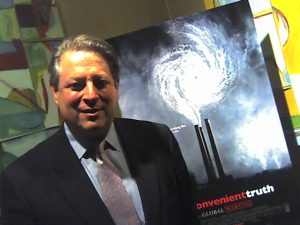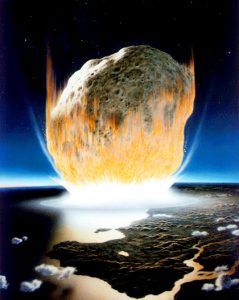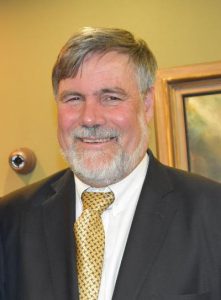Global warming is real and it’s happening, but a geology professor reckons the current focus on it is short-sighted, distracting from more pressing environmental problems. Mike Watkeys’ “deep time” perspective has irked leading climate scientists. Matthew Hattingh and Fred Kockott report.
TORNADOS struck the Kwazulu-Natal Midlands in South Africa last week, not far from where more than 300 environmental researchers, conservationists and wildlife experts had earlier gathered to explore ideas in countering severe biodiversity loss.
A rich variety of subjects were on programme of The Conservation Symposium – a seven-year-old annual event.
Delegates read learned papers on mountain grasslands. They briefed peers on efforts to save the little Pikersgill’s reed frogs of lowland KZN. And cast light on the mysterious cephalic fins found on manta rays, off Mozambique.
Through much of it ran a common thread: climate change.
At a subsequent gathering in Durban, the 17th African Ministerial Conference on the Environment (AMCEN), mayor Mxolisi Kaunda, reckoned the recent tornados were another sign our planet was going to hell in a climate change handcart.
Vulnerable
Kaunda said the city, like the rest of the world, was vulnerable to unpredictable weather changing conditions and that the recent tornados were a result of climate change.
The Conservation Symposium and AMCEN conference followed close on the heels of a declaration of a climate emergency by 11,000 scientists from across the world, warning of “untold suffering” without urgent action.
The declaration was based on analysis of more than 40 years of publicly available data covering a range of measures from energy use to deforestation and carbon emissions.
The scientists warned that despite 40 years of global climate negotiations, the problem of global warming had not been addressed. Now a “climate crisis” had arrived, accelerating faster than most scientists expected.

Sharp point
But at the symposium in Howick, Mike Watkeys, emeritus professor of geology at the University of KwaZulu-Natal, preferred to take a more long-term view on the subject – 4 billion years or so.
An avuncular, bearded man in shorts and brandishing a carved walking stick with a sharp point (purchased that morning from the African Raptor Centre as a pointer in case of a First World technology failure, he quipped), Watkeys gave one of the keynote addresses at the start of the 4-8 November symposium.
Provocatively entitled “Climate change a necessity for evolution and a driving force for civilisation”, Watkeys’ opening PowerPoint slide featured an 1838 painting, “The Fighting Temeraire” a favourite among the British public.
The evocative oil on canvas by the English Romantic artist, JMW Turner, shows the HMS Temeraire, a ship that had seen distinguished service at the Battle of Trafalgar, being towed away to a Thames graving dock by a paddle-wheel tug.
The magnificent red sunset in the picture is thought by researchers to be the consequences of volcanic eruptions, predominantly in Indonesia, which spewed dust and gas into the atmosphere.
Beyond that, in the realm of the man-made, the age of sail was giving way to steam. The Industrial Revolution was gaining momentum and a decade later reliable recording of temperatures would begin.
In other words, the painting predates by just a few years, the base year for a lot of today’s thinking on global warming.

Ancient clues
But geologists, Watkeys said, were able to look a lot further back than the mid-19th century.
Tree rings gave them a picture of climate dating back 13,900 years; ice cores could take them back 800,000 continuous years; sedimentary records and oxygen isotope signatures including of micro-fossils, 70 million years; and rock types and sequences allied to an understanding of continental drift, 4,000 million years.
Finally, rock type mapping could take geologists back to when the Earth was young – about 4 billion years ago – providing clues to ancient climates.
Watkeys put up a slide of the “hockey stick graph” reflecting how global temperatures had gone from relatively stable to curve dramatically upwards around 1850.
The graph was among research that former US vice-president Gore presented in “An Inconvenient Truth”, the popular climate change film. The short-term data the graph relied on, quipped Watkey, was, from a geological perspective “a convenient lie”.

Often, the Earth was much hotter than it was today, with no ice caps at the poles, said Watkey. He noted that 55 million years ago it was 12C hotter, yet ecosystems adapted and mammalian life flourished and radiated thanks to the virtual extinction of dinosaurs – believed to have been largely wiped out by meteorites.
He said ice ages, like the current one, were “infrequent and unusual”. They occurred at roughly 300 million year intervals and usually last for only a few million years.
Hokey Pokey
He suggested to delegates that the lyrics of the “Hokey Pokey”, the old dance ditty, provided a more useful metaphor for understanding climate change over the long haul. It involved, he said, much putting in and out different variables and then, as the song says, “you shake it all about”.
Here, Watkeys mentioned changes in solar activity relating to cyclical changes in the eccentricity of the Earth’s orbit around the sun, as well as shifts in the planet’s axis. And he noted a strong correlation had been confirmed between these Milankovitch cycles and global temperatures over time.
Catastrophic events like meteorite strikes and volcanic eruptions also played a significant role.

And while all this was going on, continental drift served to really shake things all about by, for example, allowing polar waters to circulate more, cooling global temperatures.
Watkeys in a subsequent interview said: “The impression that seems to be given to the public is that the climate was always stable before and was now was changing because of the industrial revolution.”
Watkeys said people were not being told enough about how climate change has changed in the past.
Since the last glacial maximum (about 22 000 years ago) natural warming had caused sea level to rise, he said. On top of that there’s the warming that terminated the Little Ice Age. So even without the contribution of post-Industrial Revolution warming, the complex infrastructures that have developed at coasts would be at risk and have to shift, he said.
The problem was that humans had “completely changed” the landscape making it difficult for ecosystems to move or for terrestrial animals to migrate.
Reluctant
He was reluctant to comment on the rate at which climate change was taking place – “that aspect I leave that to the climate scientists to deal with” – describing it as a “minefield”, with a yet-to-be understood divergence now emerging between terrestrial and satellite modelling.
But he questioned the frequently heard claim that the current rate of change was the highest ever as well as predictions of yearly temperature increases to the third decimal place.
“How do you measure to that accuracy?” he asked
“We are not in a natural system. The big debates are how much is caused by human activity and how much is natural. You are never quite sure. People keep coming up with different figures for the rate of change,” he said.
His second-to-last slide, which he later admitted was cherry-picked to spark discussion, showed how since 800 AD the variations in temperature through the Medieval Warm Period, the Little Ice Age (from 1350 to 1850 AD) and the post Industrial Revolution warming closely match the record of solar activity.
Now what?
So what should we do about our now increasingly warm planet?
“I am not sure what the Climate Change Panel is going to do to stop continental drift,” he quipped, referring to the UN’s Intergovernmental Panel on Climate Change (IPCC).
Carbon sequestration by planting trees could help reduce rising CO2 levels that contribute to the greenhouse effect, but needed to be carefully managed so as not to do ecological harm, said Watkeys.
A more obvious area to address, he suggested, were the Amazon rainforests, where destruction in the past 20 to 30 years had been “horrific”.
Watkeys acknowledged he was at risk of sounding like a fuddy-duddy, but said when he was a student, the two Ps – pollution and population – were routinely named as the most pressing environmental worries.
Bereft of logic
A growing population stoked consumption which led to further demands for energy, resulting in atmospheric pollution, but trying to deal with population control quickly becomes a huge religious and political argument, bereft of logic.
“I was at a climate panel meeting where the woman in charge of food security said: ‘There’s no problem. In 2050 we will be able to feed a population of 10 billion on this planet.’ Ah, ok, in calories maybe, not in nutrients,” said Watkeys. “And what about everything else, one of which is water . . . and where will all the waste go? To me that is the critical issue. If 2050 is 10 billion, by 2100 it’s going to be 30 billion people.”
[blockquote style=”1″] To me that is the critical issue. If 2050 is 10 billion, by 2100 it’s going to be 30 billion people[/blockquote]
“There are going to be too many people; not enough reserves and people are going to really fight over those resources. That’s the bigger picture,” said Watkeys.
But taking the geologist’s long view, and with tongue firmly in cheek, Watkeys counselled against despondency.
“Ultimately the good news, though… is that eventually the sun is going to expand as a red giant and absorb the Earth, so we don’t really have to worry… so another about 4 billion years to go, I think.”
Muted
No leading climate change scientist had been invited to share the podium with Watkeys to present opposing views, and the immediate response from the floor was surprisingly muted.
But in an opinion piece submitted to Roving Reporters after the symposium, Khalid Mather, a UKZN environmental science masters student, wrote: “Professor Watkeys was tasked with unravelling a difficult and controversial headline act. Much to this young scientists dismay he chose to stick to his proverbial STEM guns and bury us in empirical mishmash without touching much at the core of the crisis.”
STEM is an acronym for science, technology, engineering, and mathematics.
Mather accused the retired geologist of leaving social issues related to inequality, poverty and accountability up in the air “as insignificant ghosts”.
“Maybe to a geologist, who has the luxury of stepping back and observing the temporal and geological conditions of the climate and planet, our house may not be on fire but for many of those materially affected by rising tides, rampaging wildfires and intense tropical storms knowing that in fact these events have all happened before is no succour at all,” said Mather.
Scathing
Word soon spread about Watkey’s symposium presentation.
Professor Bob Scholes, of Wits University’s Global Change and Sustainability Research Institute, was scathing.
“It is interesting to me that such a disproportionately high fraction of South African climate sceptics (they deny being deniers, but fail to respond to evidence) are geologists,” said Scholes.
“They put it down to having a unique, ‘deep time perspective’, but that is just hubris,” he said. “Lots of other disciplines, from cosmology to paleoecology to evolution, have a deep time perspective, but retain the intellectual flexibility to able to tell that applying deep-time logic to events taking place over decades to centuries is simply misplaced.”

“Having spent their lives looking for hydrocarbons and finding deposits whose exploitation has led to great local damage, they are unable to admit that they have some responsibility for the current state of the planet. So there is denialism going on, but of a different sort,” said Scholes.
“Yes, the current dire state of the planet has many causes,” said Scholes. But climate change was in a class on its own: “all-pervasive, many faceted, effectively irreversible, and for modern complex human societies, existentially threatening.”
Misleading
Anton Cartwright, an economist and lead author of the latest IPCC report, also said Watkey’s perspective was misleading.
“If you care for life, this is not a time to be sanguine or adopt a 100,000year perspective,” said Cartwright. “Climate systems are indeed complex and our models of climate systems and climate impact are limited, but the science of warming is actually quite simple,”
“The world won’t end (because of climate change) in 2030 as sometimes reported, but life in the second half of the century will be difficult to maintain for many if we don’t cut emissions. What we do in the next two decades will be determinant,” he said.
But Cartwright acknowledged that all “views can be heard, and all science should always be challengeable.”
“That is our lifeblood – so perhaps the conversation is welcome,” said Cartwright.
This view is shared by Professor Timothy O’Connor, a lead scientist with the South African Environmental Observation Network.
Excellent foundation
In the symposium’s closing plenary, O’Connor described Watkey’s address as “an excellent foundation for looking at the nature of thinking and science that should be associated with critical discussion on climate change.”
“It is complex. It is not simply a system of ‘we are burning gases, the atmosphere is leaking’. There is more to it, and more so than that, threats (to biodiversity) are far more complex than climate change … There are a number of countries that have a miniscule amount of natural assets left,” said O’Connor. “We need to recognise the full spectrum of these threats before we formulate responses.”
Ian Rushworth, a manager with Ezemvelo KZN Wildlife’s Ecological Advice Division, also said he did not believe Watkeys had set out to cast doubt on the fact that mankind was having a considerable effect on the climate.
Uncertainty
“The science is emphatic with large degree of consensus among climate scientists, but as with complex models there is still – and always will be – levels of uncertainty in the model predictions and disentanglement of ‘natural, from ‘anthropogenic’ (social, political and economic) drivers.
“The consensus is overwhelmingly in support of the anthropogenic driver changing things over and above any natural changes,” Rushworth said. “Billions of tonnes of carbon sequestered over hundreds of millions of years, and humanity releases a significant portion of that into the atmosphere in a few hundred years…..how can that not have an impact?” asked Rushworth.
And at the end of the long interview that probed his deep time perspective, Watkeys was highly critical of the continued dependence on fossil fuels and US President Donald Trump’s “undoing almost of all the critical environmental laws that (Barack) Obama (Trump’s predecessor) had put in place. “He wants coal to be king. That’s totally idiotic,” said Watkeys, describing Trump as a “f***ing moron”. – Roving Reporters













